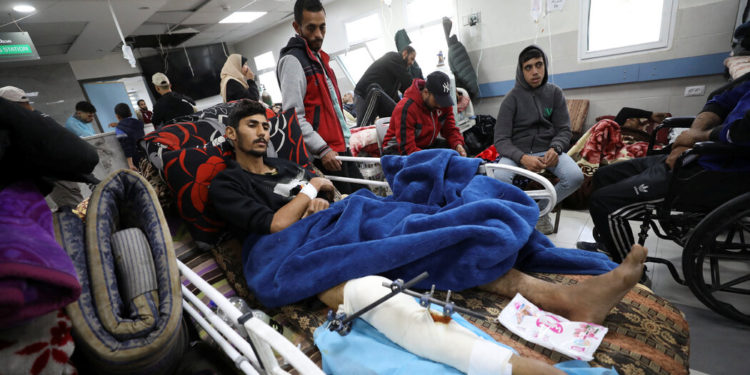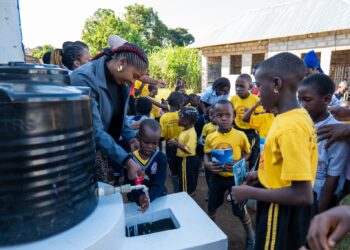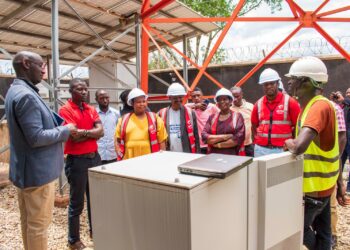By THE NEW YORK TIMES
The Gaza aid convoy that ended in bloodshed this week was organized by Israel itself as part of a newly hatched partnership with local Palestinian businessmen, according to Israeli officials, Palestinian businessmen and Western diplomats.
Israel has been involved in at least four such aid convoys to northern Gaza over the past week. It undertook the effort, Israeli officials told two Western diplomats, to fill a void in assistance to northern Gaza, where famine looms as international aid groups have suspended most operations, citing Israeli refusals to greenlight aid trucks and rising lawlessness. The diplomats spoke on condition of anonymity given the sensitivity of the matter.
Israeli officials reached out to multiple Gazan businessmen and asked them to help organize private aid convoys to the north, two of the businessmen said, while Israel would provide security.
The United Nations has warned that more than 570,000 Gazans — particularly in northern Gaza — are facing “catastrophic levels of deprivation and starvation” after nearly five months of war and an almost complete Israeli blockade of the territory after the Oct. 7 attacks led by Hamas.
Some residents have resorted to raiding the pantries of neighbors who fled their homes, while others have been grinding up animal feed for flour. U.N. aid convoys carrying essential goods to northern Gaza have been looted — either by civilians fearing starvation or organized gangs — amid the anarchy that has followed Israel’s ground invasion.
“My family, friends, and neighbors are dying from hunger,” said Jawdat Khoudary, a Palestinian businessman who helped organize some of the trucks involved in the Israeli relief initiative.
The convoy that arrived in Gaza City before dawn on Thursday ended tragically. More than 100 Palestinians were killed after many thousands of people massed around trucks laden with food and supplies, Gazan health officials said.
Israeli and Palestinian officials and witnesses offered sharply divergent accounts of the chaos. Witnesses described extensive shooting by Israeli forces, and doctors at Gaza hospitals said most casualties were from gunfire. But the Israeli military said most of the victims were trampled in a crush of people trying to seize the cargo.
Israel also acknowledged that its troops had opened fire at members of the crowd who, the military said, approached the troops “in a manner that endangered them.”
The deaths sparked global outrage and increased pressure on Israel to reach a cease-fire agreement with Hamas that would let more aid into Gaza.
The United States has been trying to broker such a deal, and on Saturday, as the U.S. began its own effort to airdrop aid to Gaza, American and Israeli officials said that Vice President Kamala Harris will meet with Benny Gantz, a member of the Israeli war cabinet, at the White House on Monday.
Israel has agreed to a plan that would include a six-week cease-fire, the release of dozens of the most “vulnerable” Israeli hostages in Gaza and the entry of more aid convoys into the territory, an American official said.
The United States and other countries, including Egypt and Qatar, are trying to persuade Hamas to accept the deal, the American official said Saturday, speaking on condition of anonymity to discuss ongoing diplomacy.
On Saturday afternoon, three U.S. Air Force cargo planes released 66 pallets containing 38,000 ready-to-eat meals over southwest Gaza — a tiny fraction of the food and other supplies needed in a territory of 2.2 million people. President Biden had announced the airdrops on Friday, saying, “Innocent lives are on the line.”
Izzat Aqel, a Gazan businessman who told The New York Times that he had helped coordinate trucks in Thursday’s convoy, said an Israeli military officer had asked him about 10 days earlier to organize aid trucks to northern Gaza with as much food and water as possible.
And on Thursday, an Israeli military spokesman, Lt. Col. Peter Lerner, said that this particular convoy was part of humanitarian operations over several days in northern Gaza that Israeli troops were overseeing.
“Over the last four days, convoys like we conducted this morning — this morning was 38 truckloads — passed into northern Gaza to distribute food supplies which are international donations but on private vehicles,” he told Britain’s Channel 4 television.
The convoy that ended in disaster left the Kerem Shalom crossing between Israel and Gaza before heading for areas of northern Gaza that had not seen aid in weeks, Mr. Aqel said. In an attempt to ensure the trucks’ safety, he added, they ventured into northern Gaza in darkness at around 4:45 a.m.
Since the war began, Israel has been loath to take responsibility for caring for Gaza’s civilians. But its bombing campaign and ground invasion have decimated Hamas’s control over northern Gaza, leaving a gaping security vacuum amid a humanitarian catastrophe that worsens daily.
Conditions have deteriorated rapidly. The number of aid trucks entering Gaza dropped significantly in February, both because of rising lawlessness and Israel’s insistence on inspecting every truck, aid groups have said.
The signs of desperation have been growing more apparent as time passes. Gazan residents have resorted to eating leaves and animal feed, and the Gazan health authorities reported this week that some children have died of malnutrition.
President Biden had said on Friday that the United States would begin airdropping humanitarian relief supplies into Gaza, working with Jordan, which has been at the forefront of such efforts recently, as well as other allies.
But the plan met with immediate criticism from international aid groups who said it would be ineffective and distract from more meaningful measures like pushing Israel to lift its siege of Gaza.
“Airdrops do not and cannot substitute for humanitarian access,” the International Rescue Committee, a New York-based aid organization, said in a statement on Saturday. “Airdrops are not the solution to relieve this suffering, and distract time and effort from proven solutions to help at scale.”
Egypt, France, Jordan and the United Arab Emirates have participated in aid airdrops to Gaza, but experts say they are inefficient, expensive and cannot possibly deliver enough aid to avert famine. Given the drawbacks, as well as dangers to people on the ground, airdrops are typically a last resort.
The United States and other countries should instead focus their efforts on “ensuring Israel lifts its siege of Gaza” and getting Israel to reopen border crossings to allow the unimpeded movement of fuel, food and medical supplies, the International Rescue Committee said.
As hunger deepens across Gaza, United Nations officials have warned that famine is imminent. Categorizing a food crisis as a famine is a technical process requiring analysis from food-insecurity experts.
According to the Integrated Food Security Phase Classification, known as the I.P.C., which is controlled by United Nations and major relief agencies, three conditions must be met before a food shortage is declared a famine: at least 20 percent of households facing an extreme lack of food, at least 30 percent of children suffering from acute malnutrition and at least two adults or four children for every 10,000 people dying each day from starvation or disease linked to malnutrition.
The I.P.C. has been selective in declaring famines, identifying only two since its founding in 2004: in Somalia in 2011 and in South Sudan in 2017. In Somalia, more than 100,000 people died before famine was officially declared.
Regardless of its technical classification, the situation in Gaza, particularly in the north, is dire. Two weeks ago, UNICEF said that one in six children in northern Gaza was severely malnourished. The Gazan Health Ministry said on Wednesday that at least six children had died in the territory from dehydration and malnutrition.
Arif Husain, the chief economist of the World Food Program, said his goal was to improve conditions before famine set in.
“For me, what is important is to basically say that, ‘Look, technically we haven’t met the conditions of a famine, and frankly we don’t want to meet those conditions,’” he said. “So please help, and please help now.”
Gaya Gupta, Vivian Nereim, Michael Crowley, Eric Schmitt and Erica L. Green contributed reporting.







Discussion about this post